Gigabyte Z77X-UP7 Review: OC Oriented Orange Overkill
by Ian Cutress on March 1, 2013 10:30 AM EST- Posted in
- Motherboards
- Intel
- Gigabyte
- Z77
Dealing with PLX 8747 Chips and PCIe Lane Layouts
The Z77 chipset specification allows Ivy Bridge CPUs to utilize the 16 PCIe 3.0 lanes in very specific layouts – x16, x8/x8, or x8/x4/x4. In order to do anything else (including 4-way), we have to put in a PCIe 3.0 switch – and the one in use on motherboards that want this functionality is the PLX 8747, which we covered in great detail back in August 2012. The upside of this chip is that for 8 or 16 lanes in, we get 32 lanes out, which can be distributed however the motherboard manufacturer wants. The downside of using this chip however is a small amount of overhead, causing a minor drop in frame rates. For the Gigabyte Z77X-UP7, we get the following configuration:
The UP7 involves a switch which allows the user to have access to a single PCIe 3.0 x16 slot without even touching the PLX chip. However the moment the user wants to add in another card, we can migrate to the orange slots via the PLX chip and maximize the bandwidth it offers. This gives five different configurations:
One card: x16 or x16 via PLX
Two card: x16/x16 via PLX
Three card: x8/x8/x16 via PLX
Four card: x8/x8/x8/x8
In this review I used the opportunity to look at our normal benchmark suite and see how much overhead the PLX chip actually affords to the motherboards that use it.
Metro2033
Metro2033 is a DX11 benchmark that challenges every system that tries to run it at any high-end settings. Developed by 4A Games and released in March 2010, we use the inbuilt DirectX 11 Frontline benchmark to test the hardware at 2560x1440 with full graphical settings. Results are given as the average frame rate from 4 runs.
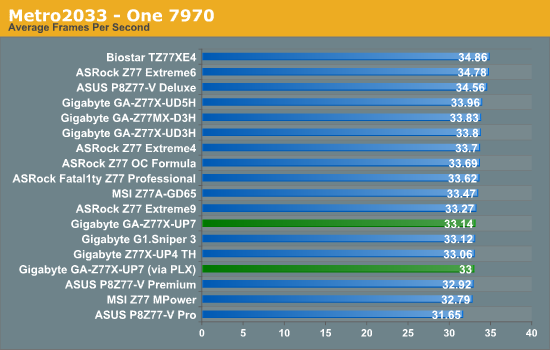
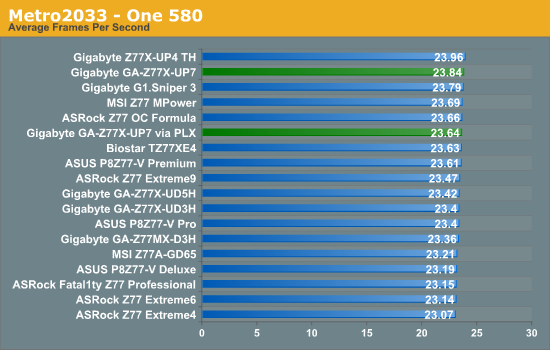
On the PLX front, the chip reduced the single AMD frame rate from 33.14 FPS to 33.00 FPS, a 0.415% decrease. On the NVIDIA side, it reduced our frame rate from 23.84 FPS to 23.64 FPS, a 0.839% decrease. Both of these are nothing much to shout about, especially given the previous NF200 on X58 was a decrease of ~2% performance. Compared to other Z77 motherboards, the UP7 takes advantage of the efficiency we saw in the CPU throughput benchmarks.
Dirt 3
Dirt 3 is a rallying video game and the third in the Dirt series of the Colin McRae Rally series, developed and published by Codemasters. Using the in game benchmark, Dirt 3 is run at 2560x1440 with Ultra graphical settings. Results are reported as the average frame rate across four runs.
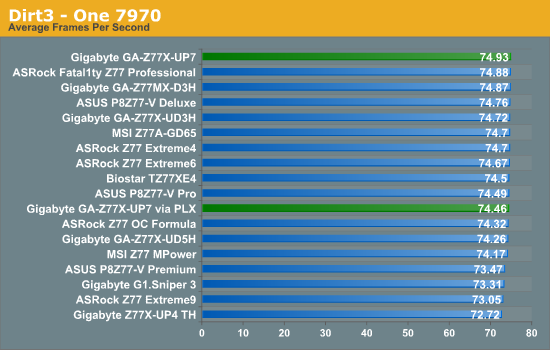
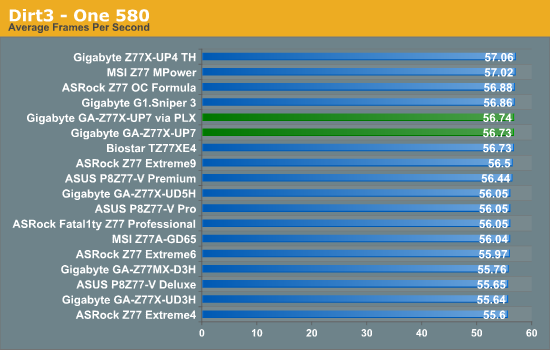
Again the PLX chip causes a minor hit to overall performance, as shown by the 1.97% drop on single card AMD (74.93 FPS to 73.46 FPS), but not so on NVIDIA (56.73-56.74 FPS) both with and without the PLX.
Other Benchmarks
As part of an upcoming update in our motherboard testing, we are moving towards newer drivers, and adding another couple of games to the test bed – Civilization V and Sleeping Dogs, both at 2560x1440 and all the graphical options turned right up. As we are not complete with this testing, we do not have any substantial tables to look through, though I do have Single GPU results on Catalyst 13.1 and NVIDIA 310.90 drivers for these games:
Civilization V:
- 86.43 FPS on HD7970
- 81.62 FPS on HD7970 via PLX
- 82.22 FPS on GTX580
- 80.40 FPS on GTX580 via PLX
Sleeping Dogs:
- 28.20 FPS on HD7970
- 27.98 FPS on HD7970 via PLX
- 16.10 FPS on GTX580
- 16.05 FPS on GTX580 via PLX
On all fronts the PLX chip causes a minor hit:
- Civ V: 5.57% on HD7970, 2.21% on GTX580
- Sleeping Dogs: 0.80% on HD7970, 0.31% on GTX580


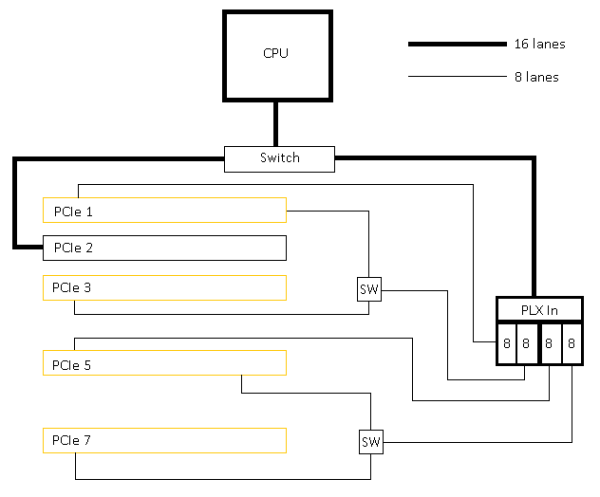








41 Comments
View All Comments
Beenthere - Saturday, March 2, 2013 - link
Don't be concerned about the $400 entry fee to the Pumpkin fanbois club, as there are quite a few kids able to spend Mommy's money on impractical toys. Asus has proved that there are many PC enthusiast suckers born every minute so Gigabyte might as well cash in on the technically dumbness, too.CeriseCogburn - Sunday, March 3, 2013 - link
With the amount of technically challenged I see here at Anand that proclaim otherwise I don't believe it has anything to do with hype for pretty colors or expensive items.Most people don't have a clue, a few have a bit, and those that do keep learning, it doesn't relate to pocketbook depth or how money is "foolishly spent", or how jealous the poorboy crybabies are when others buy the best of the best, as your personal life experience should tell you.
Without extravagant waste widespread the world would still be a 3rd world dirtbag hole, everywhere.
Pretty sick of the new crybaby constant whines - if the group of whackos isn't squealing penny pinch bang for the buck, they're whining about top end items.
I think we need a new "computer blog law" or two in order to outline the pervasive complaint themes that have become popular.
Uber_Roy - Wednesday, March 6, 2013 - link
LoL give this man a prize funnest shit i seen in a while :Pehume - Saturday, March 2, 2013 - link
And now we seem to be able to survey the field. So, looking down from this height, what would you recommend for someone who wants to get the highest overclock from a 3770k, using the lowest Voltage (thus producing the lowest temps) and doesn't do any gaming?Sniper boards seem unnecessarily fancy, with too much emphasis on GPU's. The ASRock Z77 Extreme6 or Extreme4 seem OK, but maybe not great. Somewhere between those ends is a sweet middle spot for a simple overclocker.
Given a year of Ivy Bridge, what would you recommend?
C.C. - Saturday, March 2, 2013 - link
The ASROCK Extreme4 would work perfectly for your needs! I have done several builds using the Extreme 4 and I 3770Ks. They are simply the best bang for the buck motherboard. You get all the features you need, at an awesome price. I am currently running an i7 3770K with the IHS removed (aka de-lidded) @ 4.8Ghz @ 1.272V..I have run a 48hr Prime95 stress test, and with watercooling and CL Liquid Ultra TIM, max core temps are 45,43,53,and 44C. The CL ultra is amazing, it doubled my thermal gains from de-lidding. I was using IC Diamond, and max temps were 74,73,85,and 75C.CeriseCogburn - Sunday, March 3, 2013 - link
I agree they have been pushing out some great deals for some time, although there are other brands that do well at good prices too.(I don't quibble about $5, $10, $20, $30, or $50 bucks)
IanCutress - Sunday, March 3, 2013 - link
I would never suggest aiming for the highest overclock from a CPU to run in a 24/7 machine. Find the best, then dial it back a few notches so you hit a sweet spot in terms of performance/power usage/temperatures.Ivy Bridge CPUs can vary so much, where one CPU off the shelf could take 0.1 volts less than another to hit the same clocks. For a 24/7 system, I would rather go with a motherboard that makes it easy to overclock to a nice speed rather than one that necessarily does the best. And what is the best motherboard? It's hard to tell - every CPU curve is different - is the best board one that could take a mediocre processor to new heights, or one that has the ultimate capacity to take the most expensive and best CPUs to the top in terms of performance?
Then it all comes down to price. The ASRock Z77 OC Formula, ASUS P8Z77-V Pro and GIgabyte Z77X-UD5H are all around the $210 (+/- $30) mark that will happily take a good Ivy Bridge processor to 4.8 GHz. I still have the ASUS Maximus V Formula and Gene to review shortly, as well as the G1.Sniper M3.
CeriseCogburn - Sunday, March 3, 2013 - link
LOL, good luck at the OC'ing tunaman.stren - Tuesday, March 5, 2013 - link
If you're repeating the gaming benchmarks then let's stress the PLX chip next time - 4xCF won't do that:- Use Nvidia cards because they use a ton more pci-e bw than the amd cards
- Preferably 3/4xTitans or 4x 680s as they have the most potential to be pci-e limited
- Run at super high resolutions. E.g. 3x1080p minimum, preferably 3x1440p.
This is where vega saw pcie bw issues really show up. A good comparison would be versus the R4E and the Asrock X11. I.E. native 8x8x8x8x vs PLX 8x8x8x8x vs 2xPLX 16x16x16x16x However as both those boards are x79 though I would suggest just maxing out the cpu clock rather than equalizing it as this is more fair and representative of what the high end users would do.
iamkyle - Thursday, March 7, 2013 - link
There is one thing I loved about the previous iteration of this board being the X58A-OC - the minimalist I/O panel. Although it didn't go far enough in my opinion, it was a delight to behold.The whole bit about the enthusiast community is customization - the ability to change out whatever setups they want in regards to video, ram, cooling, you name it. But yet the manufacturers still continue to force choices in sub-par audio codecs and NIC choices.
The ideal enthusiast board should be devoid of of any excess I/O outside of USB ports. I should be able to put in my audiophile-grade sound card, enterprise-class NIC, what have you without the extras being thrown in. That is true choice.